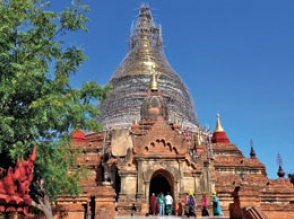Source - http://thehimalayantimes.com/fullNews.php?headline=ARCHITECTURE%3A+Pentagonal+temples&NewsID=435892

The pentagon has been used to depict various religious and occult symbolisms. The pentagram is associated to the number five. In China, they have five elements that are fire, earth, metal, water and wood. Similarly in India, they have the Pancha Tattvas, meaning five truths or realities linked to five elements: earth, water, air, fire and spirit. In Europe, a pentagram represented five senses or five virtues of the knights. The five pointed star is associated with the Jewish Star of David, the Freemasons and Bahá’í faith. The five-pointed star with a single point directed up represented the spirit over four elements. The reverse pentagram, when the single point was directed down, was considered the symbol of evil. The pentagon is also unicursal, which means that it can be drawn in one go without stopping or retracing any lines, which makes it easy to draw in the air with a wand.
The pentagon is also linked to the artistic interpretation of nature. For example, the proportion of the human figure was depicted by Leonardo Da Vinci towards the end of the 15th century in his famous drawing ‘Vitruvian Man’ using a pentagram. The pentagon is also the basis for the ‘Golden Section’ based on the proportion of 1 to 1.618, which is said to be aesthetically pleasing. The length of the different segments of regular pentagons and pentagrams are in the golden ratio.
A regular pentagon is a shape with five equal sides that join at five points at equal distances at an angle of 108 degrees. From a central point, each of five points would therefore be 72 degrees apart. This would be a difficult shape to measure out on site let alone construct an elaborate temple on. So why would the ancient architects take the trouble of creating such structures?
There have been various archaeological findings of sacred spaces created in the shape of a pentagon. It is said that Phoenicians built a pentagonal tower in Caesarea in the fifth century BCE. There were findings of pentagonal foundation remains in Jerusalem which are assumed to be the possible location of Strato’s Tower dedicated to the goddess ‘Ashtoreth’ the principal female divinity of the Phoenicians.
Further north in Lebanon the city of Heliopolis was conquered by the Romans in the second century CE where Septimius Severus is said to have built a pentagonal temple for Venus.
Several centuries later in Rajasthan India, a pentagonal temple was constructed on a pentagonal floor plan dedicated to Ambika, a form of Goddess Durga. These are some of the few examples of pentagonal structures found in history.
However, in Bagan, out of hundreds of monuments, there are 16 pentagonal structures. These are of course interesting examples of innovative designs linked to a rather interesting dilemma: there were four past Buddhas (Krakuchand, Kanakamuni, Kasyapa and Sakyamuni), but the future Buddha Maitreya also needed to be depicted. This meant that five images were to be given equal importance. Since the Buddhist pagodas, stupas or temples all have a pole at the central that connects the earth to heavens; images must be placed around the post or the pedestal of the dome.
Generally, the plan of these structures would be a mandala based on a square. To include Buddha Maitreya, architects had to convert to a pentagon. One of the earliest and largest of these structures is Dhamma-yazika Pagoda completed in 1198
AD, which is surrounded by five shrines in the form of a pentagon. A smaller temple built in the 13th century is Ein-Ya-Kyaung-Paya which has five openings on five sides with a central pentagonal column, each side providing space for the five Buddhas.
In contrast, Vajrayana Buddhism gives importance to the five Dyani Buddhas, which represent four cardinal directions and the centre, strictly defining their positions. The dilemma of positioning Dyani Buddha of the centre can therefore not be resolved by a pentagonal plan. This is probably one reason why Mahachaityas of Kathmandu still retain the square plan.